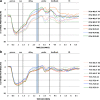Dissociable influences of reward motivation and positive emotion on cognitive control
- PMID: 24733296
- PMCID: PMC4072919
- DOI: 10.3758/s13415-014-0280-0
Dissociable influences of reward motivation and positive emotion on cognitive control
Abstract
It is becoming increasingly appreciated that affective and/or motivational influences contribute strongly to goal-oriented cognition and behavior. An unresolved question is whether emotional manipulations (i.e., direct induction of affectively valenced subjective experience) and motivational manipulations (e.g., delivery of performance-contingent rewards and punishments) have similar or distinct effects on cognitive control. Prior work has suggested that reward motivation can reliably enhance a proactive mode of cognitive control, whereas other evidence is suggestive that positive emotion improves cognitive flexibility, but reduces proactive control. However, a limitation of the prior research is that reward motivation and positive emotion have largely been studied independently. Here, we directly compared the effects of positive emotion and reward motivation on cognitive control with a tightly matched, within-subjects design, using the AX-continuous performance task paradigm, which allows for relative measurement of proactive versus reactive cognitive control. High-resolution pupillometry was employed as a secondary measure of cognitive dynamics during task performance. Robust increases in behavioral and pupillometric indices of proactive control were observed with reward motivation. The effects of positive emotion were much weaker, but if anything, also reflected enhancement of proactive control, a pattern that diverges from some prior findings. These results indicate that reward motivation has robust influences on cognitive control, while also highlighting the complexity and heterogeneity of positive-emotion effects. The findings are discussed in terms of potential neurobiological mechanisms.
Figures









Similar articles
-
Positive affect versus reward: emotional and motivational influences on cognitive control.Front Psychol. 2011 Oct 19;2:279. doi: 10.3389/fpsyg.2011.00279. eCollection 2011. Front Psychol. 2011. PMID: 22022318 Free PMC article.
-
Reward elicits cognitive control over emotional distraction: Evidence from pupillometry.Cogn Affect Behav Neurosci. 2019 Jun;19(3):537-554. doi: 10.3758/s13415-018-00669-w. Cogn Affect Behav Neurosci. 2019. PMID: 30488225
-
Differentiating Motivational from Affective Influence of Performance-contingent Reward on Cognitive Control: The Wanting Component Enhances Both Proactive and Reactive Control.Biol Psychol. 2017 Apr;125:146-153. doi: 10.1016/j.biopsycho.2017.03.009. Epub 2017 Mar 18. Biol Psychol. 2017. PMID: 28322986
-
Emotional modulation of control dilemmas: the role of positive affect, reward, and dopamine in cognitive stability and flexibility.Neuropsychologia. 2014 Sep;62:403-23. doi: 10.1016/j.neuropsychologia.2014.07.015. Epub 2014 Jul 25. Neuropsychologia. 2014. PMID: 25068705 Review.
-
Positive emotions have a unique capacity to capture attention.Prog Brain Res. 2019;247:23-46. doi: 10.1016/bs.pbr.2019.02.001. Epub 2019 Mar 1. Prog Brain Res. 2019. PMID: 31196436 Review.
Cited by
-
Emotional Modulation of Conflict Processing in the Affective Domain: Evidence from Event-related Potentials and Event-related Spectral Perturbation Analysis.Sci Rep. 2016 Aug 11;6:31278. doi: 10.1038/srep31278. Sci Rep. 2016. PMID: 27511609 Free PMC article.
-
Effects of reward on spatial working memory in schizophrenia.J Abnorm Psychol. 2018 Oct;127(7):695-709. doi: 10.1037/abn0000369. J Abnorm Psychol. 2018. PMID: 30335439 Free PMC article.
-
Translating in times of crisis: A study about the emotional effects of the COVID19 pandemic on the translation of evaluative language.J Pragmat. 2021 Apr;176:29-40. doi: 10.1016/j.pragma.2021.01.018. Epub 2021 Jan 26. J Pragmat. 2021. PMID: 36568524 Free PMC article.
-
Executive Functioning and the Pursuit of Happiness.Learn Motiv. 2021 Nov;76:101758. doi: 10.1016/j.lmot.2021.101758. Epub 2021 Aug 31. Learn Motiv. 2021. PMID: 34565894 Free PMC article.
-
Reward Modulates Unconsciously Triggered Adaptive Control Processes.Iperception. 2022 Feb 14;13(1):20416695211073819. doi: 10.1177/20416695211073819. eCollection 2022 Jan-Feb. Iperception. 2022. PMID: 35186249 Free PMC article.
References
-
- Aarts H, Custers R, Veltkamp M. Goal priming and the affective–motivational route to nonconscious goal pursuit. Social Cognition. 2008;26:555–577. doi: 10.1521/soco.2008.26.5.555. - DOI
-
- Aboitiz F. Dynamics of a neuromodulator—II. Dopaminegic balance and cognition. In: Aboitiz F, Cosmelli D, editors. From attention to goal-directed behavior: Neurodynamical, methodological, clinical trends. Berlin, Germany: Springer; 2009. pp. 205–228.
Publication types
MeSH terms
Grants and funding
LinkOut - more resources
Full Text Sources
Other Literature Sources

